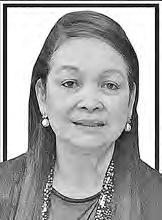


CANDID PERSPECTIVES etHniC MediA Like HFC Rises As MAinstReAM MediA FRAgMents


CULTURAL LECTURE REVIEW
OPINION
tHe FiLipino AMeRiCAn AgendA in 2024
HiMig ng piLipinAs sA nAkARAAng sigLo (ContRiButions oF FiLipino woMen to pHiLippine pop MusiC in tHe LAst 100 YeARs)

HAWAII-FILIPINO NEWS
A RepoRt: HAwAii Residents, Businesses Lose MiLLions to inteRnet CRiMes
APRIL 6, 2024

EDITORIAL
Social Security and Medicare Is on the Ballot, Don’t Be Fooled by Mixed Messaging I S
t’s clear why AARP is known in D.C. as the most powerful lobbying group in the United States. Social Security and Medicare are considered the most important government programs and receive near-universal support in the high 90s-percentile, according to polls.
The electorate who supports Social Security and Medicare transcends all political divisions, representing Democrats, Republicans and independents. This electorate transcends identity politics of race, gender, sexual orientation, ideology and economic class. This electorate is the true reflection of “united” in the United States of America.
No other issue but Americans’ unwavering support for Social Security and Medicare has managed to bring our nation together, even now in our hyper-toxic, hyper-divisive political landscape.
And this massive support for Social Security and Medicare has managed to minimize the influence -- to a degree but with few exceptions -- of lobbyists and corporate special interests on government in ways unseen. It has been done so successfully since the two entitlement programs were created decades ago.
This is extraordinary in the history of politics in this country. It is the rarified double rainbow hoovering over Congress’ dark clouds.
But make no mistake. There have been powerful efforts to privatize parts of Social Security. And corporate interests have had penetrating effectiveness in the Medicare program as Medicare Advantage (a private, pseudo-government enterprise) gains strength, undermining the true intent of Medicare’s founding principles.
Why the success of Social Security and Medicare?
Biology, vulnerability, morality and fairness – all play important roles in protecting and defending Social Security and Medicare.
In our inescapable aging process that we are universally beholden to biology, at some point our physical bodies are no longer able to keep up with productivity, which gives way to a vulnerability we all must face.
Productivity is the driving force of our economic system and it’s unforgiving except in the case of aging and its universality. The second point of universality is a significant one because rest assured if there were ways for more of us (no longer near-universal) to circumvent this vulnerability – it’s highly likely Social Security and Medicare would not receive the near 100% support they are getting.
It can be argued there are a few in society who are wealthy enough and therefore not exposed to “financial” vulnerability in old age (which explains the 1 or 2 percent who say that Social Security and Medicare entitlements are too much). But this is where the moral aspect, namely compassion and empathy, manifests in policy. There is still a remnant of healthy tribalism and survival as a species phenomenon that will find it moral to ensure our vulnerable in society (seniors) will be taken care of. Children are also vulnerable but are far more likely to be cared for by their parents than seniors being taken care of by their adult children.
The last point: Social Security and Medicare programs themselves as a system is a fair one. It’s smartly designed that in our younger more productive years we deposit our money into a system from which we can enjoy the dividends later in our older and less productive years. It’s a fair system worth keeping and defending.
o far in our election year coverage series this year, we’ve done in-depth cover stories on abortion and immigration reform. We believe in presenting more issues-based coverage than personality sensationalism that the mainstream media tends to focus on with regard to the presidential election.

For our cover story this issue we present another top issue that is on the ballot – Social Security and Medicare, which have been consistently ranked as the most important government programs among seniors, polls show. What are Joe Biden and Democrats plans to secure the preservation and success of these entitlements? What has Republicans in Congress proposed in their recently released 2025 budget and what is Donald Trump’s mixed messaging on Social Security and Medicare? Associate editor Edwin Quinabo outlines these opposing differences in the cover story that all voters should know leading into the November General Election. We also have members in our community sharing their perspective on how these entitlement programs affect their livelihoods and their opinions on possible changes to them.
Keeping on politics, we have three insightful articles. First, HFC contributor Sheryll Bonilla, Esq submits the first in a twopart series, “The Bottom Up and the Middle Out – Bidenomics Is Great for the Economy!” She writes, “it is so critical to the health of the economy that our nation’s tax and economic policies are structured with the ‘bottom-up and middle-out’ as its focus.” Second, we have a highly evocate second editorial titled, “Bold Political Reform to Shake Up the Establishment Could Redeem Biden’s Desperate Reelection Bid; Look to Ro Khanna’s 5-point Plan.” Third, HFC columnist Arcelita Imasa, M.D. contributes “The Filipino American Agenda in 2024,” which frames some challenges our Filipino community faces and how Filipino organizations are working to amplify our demands so that politicians will hear us.
Relatedly, as media is a vehicle to spur political action, HFC columnist Emil Guillermo contributes “Ethnic Media Like HFC Rises as Mainstream Media Fragments.” He writes, “If you didn’t see your Black, Brown, or Asian story, idea, or thought reflected in places like The New York Times, you could always get it in the ethnic media. But now as our country has grown more diverse, all of the media has taken the condition of the ethnic media.”
Switching gears, we have an interesting cultural piece submitted by HFC columnist Rose Cruz Churma, “Himig ng Pilipinas sa Nakaraang Siglo (Contributions of Filipino Women to Philippine Pop Music in the Last 100 Years),” a review on Paul Gabriel L. Cosme’s lecture on the title’s subject. The lecture was co-sponsored by the Philippine Consulate General in Honolulu and the Filipino Association of University Women (FAUW).
Lastly, are you tired of seeing dubious money-scam ads posing as opportunities for wealth while you surf the internet and think that more needs to be done by the government in consumer protection. In our news section, we have an article, “ A Report: Hawaii Residents, Businesses Lose Millions To Internet Crimes.” The annual FBI Internet Crime Report released last month revealed that Hawaii residents and businesses reported losing $51.7 million to internet crimes in 2023 which is a 45% increase over the $35.8 million reported in 2022. This type of crime is clearly a problem, and this article alerts our community to be vigilant against such scams. We hope you enjoy these stories as well as our other columns and news.
Thank you for supporting the Hawaii Filipino Chronicle. Remember to visit www.thefilipinochronicle.com for your free e-copy of the Chronicle. Until the next issue, Aloha and Mabuhay!

Rose Cruz Churma
Elpidio R.
Mark Lester Ranchez
Jay Valdez, Psy.D.
Glenn Wakai
Amado Yoro
Philippine Correspondent:
Greg Garcia
Neighbor Island Correspondents:
Big Island (Hilo and Kona)
Grace LarsonDitas Udani
Kauai
Millicent Wellington
Maui
Christine Sabado
Big Island Distributors
Grace LarsonDitas Udani
Kauai Distributors
Amylou Aguinaldo
Nestor Aguinaldo
Maui Distributors
Cecille PirosRey Piros
Molokai Distributor
Maria Watanabe
Oahu Distributors
Yoshimasa Kaneko Shalimar

2 HAWAII FILIPINO CHRONICLE APRIL 6, 2024
Publisher & Executive Editor Charlie Y. Sonido, M.D. Publisher & Managing Editor Chona A. Montesines-Sonido Associate Editors Edwin QuinaboDennis Galolo Contributing Editor Belinda Aquino, Ph.D. Design Junggoi Peralta Photography Tim Llena Administrative Assistant Lilia Capalad Editorial & Production Assistant Jim Bea Sampaga Columnists Carlota
FROM THE PUBLISHER
Hufana Ader
Estioko
Espero Perry Diaz Emil Guillermo Arcelita Imasa, M.D.
Moraleda-Puguan
Orias
Sonido, M.D.
Tipon,
Contributing Writers
Bautista Edna Bautista, Ed.D. Teresita Bernales, Ed.D. Sheryll Bonilla, Esq. Dr. Dylan Bothamley Serafin Colmenares Jr., Ph.D. Linda Dela Cruz Carolyn Weygan-Hildebrand Amelia Jacang, M.D. Caroline Julian Max Levin Raymond Ll. Liongson, Ph.D. Federico Magdalena, Ph.D. Matthew Mettias Maita Millalos Paul Melvin Palalay, M.D. Renelaine Bontol-Pfister Seneca Moraleda-Puguan
Willie
Seneca
J.P.
Charlie
Emmanuel S.
Esq.
Clement
/ Jonathan Pagulayan Advertising / Marketing Director Chona A. Montesines-Sonido Account Executives Carlota Hufana Ader JP Orias (continue on page 3)
Bold Political Reform to Shake Up the Establishment Could Redeem Biden’s Desperate Reelection Bid; Look to Ro Khanna’s 5-point Plan
rump’s real shine
TAsk Trumpers or politicos to explain the real reason behind Donald Trump’s political shine and they will tell you it’s because Trump is not a politician, a perceived outsider of the establishment even as he’s held the top executive post in government and politicized the D.C. game to the hilt.
Perception matters and Trump’s unrefined, street-talk ways of speech, crude and non-politician brash demagoguery and irreverent posturing – all work well to support this anti-establishment persona, while reality points to Trump as the mastermind insider of the modern GOP establishment.
Why does the anti-establishment image matter and is so appealing? It’s because all the frustration that Americans have that their government has failed them, their disappointment in politicians and their angst at the rot in D.C. politics can be honed and translated into votes. Apparently, into lots of votes as polls show a grossly imperfect candidate in
Disturbing proposals
Despite Social Security and Medicare’s near universal support, there are attempts to change parts of these programs in harmful ways.
The raising of the eligibility age for Social Security (proposed by Republicans in Congress) from currently 62-67 years old (partial benefits), 70 years old (full benefits) to age 70 and higher under the justification that our population is living longer is simply a ruse and should rouse adamant rejection.
Average life expectancy does not equal healthy life expectancy. Unless scientists have come up with some elixir to make the two indistinguishable that argument falls flat and should be discarded without consideration.
Trump is at the verge of winning a second presidency.
What exactly does the establishment represent to millions of disillusioned voters? Americans are sick of corruption, that their multitudes of wealthy representatives in Congress keep getting elected year after year with having little to show in accomplishments.
Americans are tired of big money influence from billionaire individuals, superPacs and corporations that in essence buy politicians to keep the status quo while grassroots Americans slip further into discontent, slip further into hard financial times.
Biden and Democrats need to run on political reform
To turn the tide in Biden’s desperate attempt at reelection, what he needs to do is rally for true and genuine political reform. It’s worth driving home this point: political reform, political reform.
This is the only way to shed the anti-establishment suit millions of Americans are suiting Biden with. And it doesn’t help that his rhetoric of being a populist doesn’t jibe with reality.
When you look at the
success of Barack Obama, he represented “hope,” arguably the most convincing political campaign in modern history. And it was believable given his obvious demographic, a Black American who spoke of change.
Bill Clinton’s campaign was successful because he resurrected a JFK aura, a middle-aged president – something different back then, and a vice president pick in Al Gore who mustered similar demographic appeal.
Obama and Clinton at their prime seeking election were perceived as fresh and anti-establishment, even though history tells this turned out to be only marginally true.
Americans do not look at Biden in the lens of hope nor is he middle-aged (symbolic of transition, kinetic, of going to new places and change).
This is why Biden must take on the mantle of bold political reform. And if he and his political handlers are smart, they should be looking to Rep. Ro Khanna’s (D-Calif) bold and groundbreaking 5-point, comprehensive political reform as the sale to sell to the American public.
Khanna’s 5-point plan is
exactly what Biden should not only be pushing as campaign talking points, but meaningfully embrace it as a hopeful plan for a new America. What is Khanna’s 5-point plan?
1) Ban all PAC (political action committee) and lobbyist money from congressional campaigns.
2) Ban members of Congress from stock trading, as well as ever becoming lobbyists.
3) Term Limits for members of Congress.
4) Term Limits for Supreme Court Justices.
5) The implementation of an Ethics Code for the Supreme Court Justices.
Khanna said he is introducing the slate of reforms now, as a package, to inspire Biden and other Democrats to take action. He said, “There is a sense on both the left and the right of a crisis of confidence in institutions ― whether that is the Congress or the Executive Branch or the Court. That level of anger has led to a rejection of politics ― an anti-politics, which has created an opening for all kind of demagoguery and sensationalism to fill the void.”
harder to prevent sensational and demagogue-type figures from filling that void.”
Khanna is correct.
Biden’s age was never really the problem as his corporate media supporters like to push and consequently some Americans are buying into. Biden’s problem has always been that his approach to governance is old. His ideas are old.
Trump, who is just a few years younger, is not slapped with this old man image because everything about him in terms of approach to governance is not old (but for the wrong reasons). How so? No one really knows what to expect in his second term. The speculation is dictatorship. But still, how would this happen and to what extent – are keeping voters in suspense. It’s appealing (again, for the wrong reasons) because people are so desperate for change that they are even entertaining dictatorial change.
With Biden, what Americans already anticipate is more of the same thing, old politics to come from an aged man who is offering no hope for real change – a perpetuation of establishment rule.
A second proposal – also floated by Republicans – is to
change limiting and phasing out “auxiliary benefits” for those beneficiaries’ spouses and dependents. This is an assault on the traditional family who enjoys the lifestyle of an at-home mother raising her children full-time while her husband works. This proposal would upend the auxiliary benefit of Social Security being passed on to this mother who has dedicated her lifetime to receive her husband’s partial Social Security that he earned. We all know the value of a mother’s care in both a working-mother and traditional family set up. We also know the value of a husband-and-wife teamwork in raising a family.
That stay-at-home mother fairly earned part of her husband’s Social Security, whether he is alive or has passed on.
The last proposal by Repub(Social ....from page 2
licans of restructuring Medicare premium support subsidies for either traditional Medicare or private Medicare Advantage plans is so vague that it could mean anything. In other words, Medicare as is, could be open to minor or dramatic changes if Republicans have their way.
Voting Matters
Voting is usually not based off a single issue. Social Security and Medicare tend to be the top or near-top deciding factor among seniors and near-seniors. We recommend that you do your homework, be informed and vote. If protecting Social Security and Medicare is your top priority, give your federal representatives a call and let them know what matters to you. Social Security and Medicare must be protected.
He adds, “Unless the Democrats offer a bold vision of reform that we campaign on and deliver on when we win, it’s going to become harder and
Take up bold political reform, Biden, and you just might have a chance. But time is running out.

APRIL 6, 2024 HAWAII FILIPINO CHRONICLE 3
EDITORIAL
)
Filipinos Want Social Security and Medicare Protected, Republicans and Democrats Share Opposing Plans on How to Protect Them
By Edwin Quinabo
Social Security and Medicare are on the ballot in November 2024 as political parties share opposing views on both entitlement programs.
The White House and entitlements advocates reiterate that voting matters, highlighting Biden’s promise in 2020 to ease drug costs and his delivery of it in the passage of the Inflation Reduction Act after his election in August 2022. That landmark Act allowed for cheaper medicine through the federal government’s new power to negotiate prices with drugmakers for Medicare.
President Joe Biden wants voters to know cuts to Social Security will not happen on his “watch” -- hoping to elevate his campaign and corner a large sector of voting seniors and near-retirees.
While former President Donald Trump rejects the idea of changing Social Security this election cycle, Trump said that reining in spending on the program could be one way to improve the government’s budget.
Social Security and Medicare advocates said while Trump insists on not touching these highly popular entitlement programs, his past budget proposals suggest another thing. In 2020 Trump proposed a budget as president that included an estimated $71 billion in cuts to Social Security. He also proposed during the COVID-19 pandemic a payroll tax cut aimed at putting more money into workers’ paychecks, a proposal experts say would reduce the tax income Social Security and Medicare rely on.
“Make no mistake: Social Security is on the ballot in November,” said Nancy Altman, president of Social Security Works, an advocacy group for expanding the program.
Unlike Trump’s mixed messaging on the two entitlement programs, his political party last month wasn’t coy about possible changes. The Republican Study Committee, a large group of conservative House Republicans, released a 2025 budget proposal including significant reforms for Social Security and Medicare.
Rep. John Larson, D-Conn, ranking
member of the House Ways and Means Social Security Subcommittee, suggested Republicans are avoiding some specifics to their plan “because they know these cuts are unpopular with the American people.
Overwhelming majority support Social Security and Medicare
According to an AARP survey of 1,441 people ages 18 and older taken last year, there was a near-universal support for Social Security: 96% of those polled regardless of political affiliation said Social Security was either the most important government program or an important one compared with other government programs.
Support for Social Security was high across the political spectrum: 93% of Republicans, 99% of Democrats and 92% of independents see Social Security as an important government program.
“It’s crystal clear that Americans of all generations value the economic stability Social Security has offered,” said Nancy LeaMond, AARP executive vice president and chief advocacy and engagement officer.
The same poll found that since COVID-19, economic instability has boosted the importance of Social Security with 56% saying Social Security is more important now than it was before the pandemic.
LeaMond said, “With so many Americans struggling to afford health care and other basic needs, Social Security is more important than ever — and AARP will never stop fighting to strengthen Social Security and make sure hard-working Americans get the benefits they’ve earned.”
Sixty-five percent of respondents said they wish Social Security payments were larger and believed it is too low. Just 3% thought it is too high.
The average Social Security retirement payment is about $1,503 per month.
More than 69 million people — almost 9 out of 10 of those 65 and older – get Social Security benefits, according to the Social Security Administration (SSA). The Social Security Act was signed into law on August 14, 1935.

According to a recent YouGov survey, 84% of Americans who currently have Medicare benefits have a positive view of it. Fifty-three percent of Americans say it deserves a greater allocation of funds, and 23% want its finances to remain stable. Another 13% want its funding reduced (8%) or cut entirely (5%).
Recent data from the Economist/YouGov poll shows that a proposal being considered by House Republicans to cut funding for Social Security and Medicare programs would not be supported by majorities of Americans nor Republicans.
Amy Cachola, 63, Pearl City, signed up to receive early Social Security benefits last year. She retired as an accounting clerk at the age of 47 to take care of her ailing father for nine years. She hasn’t returned to the workforce after his passing because she’s been caring for her grandchildren during the daytime.
Cachola has been working since the age of 18 and receives $950 per month in Social Security benefits. She opted for early partial benefits because she said, “you never know when your time is up.”
“I could have waited until 67 to get the full Social Security benefits. But when I received notice from SSA to decide, I opted to get the partial benefits because my father passed away at 61 and he never got a chance to collect his benefits that he worked so hard for, putting into the system all his working life,” said Cachola. “I didn’t want to end up that way.”
“Now I am waiting to qualify for Medicare when I turn 65,” she said.
Cachola receives a nominal income for babysitting her grandchildren. Her husband, 71, receives his Social Security and works part-time. He worked
4 HAWAII FILIPINO CHRONICLE APRIL 6, 2024 COVER STORY
(continue on page 5)
(Filipinos Want.....from page 4) full-time until he qualified for full Social Security benefits and receives $2,700 per month.
“We rely on our Social Security benefits as our primary income, and it helps us to remain independent from our children. It also helps with our expenses that one of our adult sons lives with us and pays rent,” Cachola explained.
She said, “Without Social Security we would not have financial security and could not enjoy our part-time working status. We would not have been able to retire at all. We all know how expensive it is in Hawaii. My husband receives Medicare, but his former company has no retirement benefits. So he has a basic plan, not Medicare Advantage. I am currently paying for health insurance which is expensive.”
Cachola said in her middle age, Social Security and Medicare were not top priorities when it came to voting. But now that she and her husband are seniors, Social Security and Medicare are their top priority in choosing a candidate.
“Definitely, we both will be voting for the Democratic party for our congressional representatives and president because we don’t trust Republicans on this issue. I don’t believe Trump when he says he will not make cuts to these entitlement programs. In the past under President George W. Bush, he and Republicans tried to privatize Social Security. We don’t want changes. We deserve every cent of these entitlements because we worked hard and paid into the system,” said Cachola.
According to the same AARP survey, 89% say it would be unfair to people who are retired or near retirement to make major changes to Social Security that would affect them. Twenty-nine percent said they do not trust the government to keep its promises of guarding Social Security and Medicare.
Seniors who are economically insecure
The U.S. Census Bureau 2022 report says More than 17 million older adults age 65+ are economically insecure,
with incomes below 200% of the federal poverty level.
According to the Center on Budget and Policy Priorities (CBPP), Social Security benefits lift 16.1 million older adults above the Federal Poverty Level (FPL). The current FPL is $29,160 per year for a single person in 2023. But according to the Elder Index – a more accurate measure of economic well-being economists say – millions more older adults are struggling to meet their monthly expenses, even though they’re not considered “poor” because they live above the FPL.
The CBPP says those below the FPL struggle with rising housing and health care bills, inadequate nutrition, lack of access to transportation, diminished savings, and job loss. For older adults over the FPL, the CBPP says many of them are one major adverse life event away that could change their financial security.
The U.S. Census Bureau says nearly half of adults aged 55-66 have no personal retirement savings. The Congressional Research Service on Household Debt Among Older Americans shows that 61% of households headed by an individual age 65 or older are in debt. The median debt for senior-led households is $31,050.
Cathola said she and her husband do not receive any government assistance besides Social Security and Medicare. “I wouldn’t say we are living in poverty, but I am certain there are many others in Hawaii our age who are. But without Social Security, we certainly would be in that poverty threshold because I estimate our Social Security to be more than half of our monthly income.”
According to SSA, among Social Security beneficiaries age 65+, Social Security represents 50% or more of their income for 37% of men and 42% of women.
Senior Poverty on the Rise
In yet another metric, the supplemental poverty measure which economists have found to be a more accurate reflection of income and spending than
the official FPL, the proportion of people over age 65 living in poverty climbed to 14.4% in 2023, up from 9.5% in 2020. Millions more Americans have fallen into poverty within this period since COVID-19.
The supplemental measure defined poverty last year as an annual income below $15,998 for a single adult household ($22,624 for a two-adult household).
Teresa Ghilarducci, an economist at the New School for Social Research, said her studies show a lot of seniors live close to the poverty line. “So, it doesn’t take much to tip them over into poverty,” she said. She adds that the pandemic forced many older workers into early retirement, their companies pushed them out from the workforce.
Social Security has costof-living increases based off inflation, but there tends to be a lag on these adjustments, experts say. So even if senior poverty rates were to stabilize or decline next year, eased by higher benefits, the poverty figures would remain stubbornly high compared to those in other industrialized nations with stronger public safety nets.
Among the G7 nations – Canada, France, Germany, Italy, Japan, UK and the U.S. -- the U.S. has the highest elder poverty rate, two times more than all other G7 nations.
Ghilarducci said the Mercer/CFA Institute Global Pension Index found the U.S. system is marred by low benefits, conflicts of interest, and anemic financing for entitlement programs, compared to other wealthy countries, which is why “elderly poverty is the highest among the G7 nations.”
Comparing proposals for the upcoming election
Both Social Security and Medicare face looming insolvency dates as the number of seniors who rely on these programs is projected to grow. The Committee for a Responsible Federal Budget has estimated that the Social Security trust fund may run out in the next decade.
Medicare’s hospital insur-
“Entitlements to Social Security and Medicare need to be protected. Seniors have worked so hard and rely on them during their vulnerable aging years. I oppose raising the retirement age. Some people look forward to this milestone in their lives. For those in the hard labor jobs, it takes a greater toll on the body and health than some who work in white collar jobs. I didn’t mind my second job after the Navy, and I am blessed to still have good health. People are living longer after retirement but that doesn’t mean the government should take away the motivation to get the full benefits that we all worked so hard for.”
– Domi Viernes Ewa Beach, retiree
ance trust fund, which covers Medicare Part A, may face insolvency in 2033. The Congressional Budget Office projects that public debt could go up from 97% in 2023 to 166% by 2054, which makes funding for the two entitlement programs more difficult.
Both Republicans and Democrats agree that the current course of Social Security and Medicare is not sustainable, and changes must be implemented. But their parties’ approach to these changes are at odds.
Emerson Sprick, associate director of economic policy at the Bipartisan Policy Center, compares the two parties’ overarching philosophies on the entitlement programs. “On the right, there is a line in the sand against tax increases. And on the left, there’s this idea that we’re going to address this problem and not touch benefits,” he said.
REPUBLICAN PLAN
House Republicans’ plan calls for: 1) raising the Social Security retirement age; 2) reducing full retirement age benefits for high-income earners; 3) limiting and phasing out “auxiliary benefits” for those beneficiaries’ spouses and dependents; and 4) restructuring Medicare premium support subsidies for either traditional Medicare or private Medicare Advantage plans. Their budget did not specify the income thresh-
olds to which those changes would apply. It did not specify a new higher retirement age or when phasing out of “auxiliary benefits” would occur. It also did not specify how premium support subsidies would change.
The reforms would be gradually phased in and “affect no senior in or near retirement,” according to the plan. Ultimately, the goal for the changes is to make Social Security’s retirement trust fund “sustainably solvent.”
The Republicans’ budget proposal calls their plan “modest adjustments,” but critics disagree saying their plans lack specifics which could translate into broad reforms affecting millions of seniors.
Sprick said, “any kind of durable policy with a realistic chance of getting through Congress is going to have to include aspects from both sides.” Changes would require bipartisan agreement.
Domi Viernes, Ewa Beach, 83, retired at age 44 from the U.S. Navy’s food service. He said “entitlements to Social Security and Medicare need to be protected. Seniors have worked so hard and rely on them during their vulnerable aging years.
“I oppose raising the retirement age. Some people look forward to this milestone in their lives. For those in the hard labor jobs, it takes
APRIL 6, 2024 HAWAII FILIPINO CHRONICLE 5 COVER STORY
(continue on page 6)
New PLA Mandate Another Hit to Hawaii’s Cost of Living
By Keli‘i Akina
Politicians say they want to lower Hawaii’s cost of living, but talk is not enough.
In reality, they keep piling on rules that add to the cost of government, which leads to higher taxes and ultimately a higher cost of living.
For example, consider the “administrative directive” issued by the governor’s office in February. This new rule requires all state construction projects worth more than $1.5 million to be performed under so-called project labor agreements, or PLAs.
PLAs favor unionized contractors by requiring that bidding contractors pay so-called prevailing wages, which are set by unions.
a greater toll on the body and health than some who work in white collar jobs. I didn’t mind my second job after the Navy, and I am blessed to still have good health. People are living longer after retirement but that doesn’t mean the government should take away the motivation to get the full benefits that we all worked so hard for,” he said. He adds that Medicare premiums also shouldn’t be raised.
Like most seniors receiv-

They also require contractors to abide by union terms, use union referrals, and keep good relationships with the unions.
Making things worse, the new $1.5 million threshold is a big drop from the previous $25 million, which still was not popular with nonunionized contractors but at least considered more tolerable in terms of its effect on smaller businesses.
In fact, Hawaii’s $1.5 million PLA threshold is now the lowest in the nation — far lower than Washington D.C.’s $75 million, California’s $35 million, or even New Jersey’s $5 million.
So overall, the effect of the new PLA order will be to ice out Hawaii’s nonunionized contractors from virtually all state construction contracts — and fewer bidders typically means higher
ing Social Security and Medicare benefits, Viernes said he and his wife would be “somewhat affected, our livelihood, as we’d be forced to dip into our savings.”
His advice to seniors and near seniors, “Enjoy your earnings but be smart with your money, save some and plan for your golden years.”
He said having grown up in poverty in the Philippines, he knew to work very hard and save for his family and their future.
DEMOCRATIC PLAN.
Biden’s proposed budget opposes benefit cuts and efforts to privatize Social Security. “Both are off the table,” he said.
To help shore up the entitlement programs’ shortfall, Biden’s budget calls for the highest income Americans to pay their fair share in taxes.
But he emphasizes, “Under my plan nobody earning less than $400,000 will pay an additional penny in federal taxes,” Biden said during his recent State of the Union address. His plan includes

project prices.
A 2019 study from the Beacon Hill Institute, for instance, found that PLAs in New Jersey increased building costs for 107 public schools by 16.25%, or $565 million.
Furthermore, a 2021 RAND Corporation study found that PLAs raised the cost of a large affordable housing project by 14%, re-
raising the Medicare tax rate on both earned and unearned income from 3.8% to 5% for those earning more than $400,000. He also wants to improve Social Security and Supplemental Security income benefits for retirees and individuals with disabilities who “face the greatest challenges making ends meet.”
Like Republicans’ plan lacking specifics, critics also point out Biden’s budget stops short of specifying how the proposed combination of tax increases for those making above $400,000 annually and increasing benefits would restore Social Security’s solvency.
White House spokesperson Robyn Patterson said, “We could extend the life of Medicare’s Trust Fund permanently — without cutting benefits — if Congressional Republicans would get on board with the President’s historic budget proposal to raise taxes on the wealthy.”
Democrats have complained the Republican budget proposal would result in
sulting in the construction of 800 fewer homes.
PLA proponents claim that the agreements protect local jobs. In Hawaii, however, more than 60% of construction workers do not belong to unions — so PLAs only apply to a minority of workers here.
Another argument for PLAs is that they help avoid strikes and other labor disruptions. But strikes are a rarity these days, and PLAs still are associated with more construction delays.
For example, a 2008 report from the New Jersey Department of Labor and Workforce Development found that the average PLA project took 100 weeks to complete, compared to 78 weeks for non-PLA projects.
Meanwhile, Hawaii is moving in the wrong direction.
So, what can we do?
In the short run, the sensible thing would be for Hawaii to return to the previous PLA threshold of $25 million, or perhaps even the $35 million level used by the federal government.
In the long run, though, we should eliminate PLAs completely. Government construction projects would cost less, we possibly could see a break in our taxes as a result, and maybe fewer of our families and friends would feel the need to flee their beloved homes in search of more affordable living.
The disadvantages of PLAs are so well-known that 25 states have enacted legislation or rules barring PLA mandates on government construction projects.
$1.5 trillion in benefit cuts.
Republicans criticize Biden’s plan, saying increased taxes on the wealthy would not be enough and lead to cutting benefits of Medicare by 23% before the projected depletion date of 2033.
Recommendations to keep seniors from falling into poverty
Economists and senior advocates emphasize federal benefits go a long way toward reducing poverty. They say some suggestions that would help include: 1) raising the minimum Social Security benefit; 2) increasing Social Security payments after people reach age 85, when health care costs typically increase; and 3) improving S.S.I. benefits for older adults and people with disabilities who lack the work history to qualify for Social Security. All of these steps would require congressional action, senior advocates say.
Max Richtman, president and CEO of the National Committee to Preserve Social Security and Medicare, said
Social Security needs adequate funding. “The chronically underfunded agency has been struggling to provide proper customer service — including field office closures, long wait times on SSA’s 1-800 phone line, and excessive delays in disability insurance hearings,” he said.
Biden said he sides with the working people who built this country. “If anyone tries to cut Social Security or Medicare or raise the retirement age again, I will stop them.”
Trump said in a CNBC interview last month, “there is a lot you can do in terms of entitlements, in terms of cutting. And in terms of, also, the theft and the bad management of entitlements — tremendous bad management of entitlements — there’s tremendous amounts of things and numbers of things you can do.”
That said, he reiterated that “you don’t have to touch Social Security,” suggesting other changes could come before cuts that would hurt senior citizens.
6 HAWAII FILIPINO CHRONICLE APRIL 6, 2024 OPEN FORUM
(COVER STORY: Filipinos Want....from page 5)
KELI‘I AKINA is the president and CEO of the Grassroot Institute of Hawaii.
 By Emil Guillermo
By Emil Guillermo
aking my storytelling to theaters before live audiences has been part of my evolution in “poetic journalism.”
TFor the last few years, I’ve taken my columns and turned them into springboards for my comic memoirs that I bring to the stage.
The newest iteration of my live Amok monologues features a new story about my conversion therapy as a transdad.
Conversion Therapy? Transdad?
You can see the show in New York City starting April 5. If you’re in the area come by: https://www.frigid.nyc/ event/6897:625/. Livestreaming may be available.
Ethnic Media Like HFC Rises as Mainstream Media Fragments
But I am still honored to see my columns each week in the Hawaii Filipino Chronicle. Even when I was in mainstream media locally or nationally, I always saw my work in the ethnic media as the most important.
For example, mainstream media will gladly report poll findings on voters of color as they did after last week’s Michigan primary.
The emerging narrative in the 2024 campaign has been how President Joe Biden and the Democrats are leaking POC support, making the possibility of a Trump win greater than it should be.
In 2020, Biden was up 62% among voters of color. Last week the number shrunk. Biden is up just 21% among voters of color.
Another poll showed similar drops in Arizona, Nevada and other key states.
The white media will re-

port the headlines. The ethnic media is where we turn to understand why POC feel the way they do, and how we could be the vote that determines the future of American democracy.
I first began writing my “Emil Amok” columns on Filipinos in publications in 1991. I’ve been writing race-focused columns like this for over 30 years.
I mention this simply to indicate how much journalism has changed in that time. The
“ethnic media” was always separate from the mainstream, serving audiences that felt neglected by the white media.
If you didn’t see your Black, Brown, or Asian story, idea, or thought reflected in places like The New York Times, you could always get it in the ethnic media.
But now as our country has grown more diverse, all of the media has taken the condition of the ethnic media.
The perfect mirror that I had hoped to see in mainstream media is becoming a pipe dream. Instead of trying to serve all, journalism has become fragmented, communicating to specific audiences that exist in “news bubbles.”
At least that’s the latest take by Axios, which since its inception has dealt with the changes in journalism in its own way. It established a slightly more intellectual USA Today meets “Cliff Notes”
style it brands as “smart brevity.”
But now, in our current divided America, diversity has proven to be too polarizing to create a mass audience that sustains mainstream media. Profits are smaller than greed demands.
Big Media is discovering that fragmenting into news silos is the only capitalistic thing to do. You make more money going for the niches among whites.
It’s an unfortunate turn because profit is now the arbiter of truth.
If there is no one set of facts that we as Americans can agree on, the news media now gladly serves up whatever an audience wants, not what it needs to know.
This is the mentality that gives us Fox, NewsMax, and One America. One is right, the other righter, the other
(continue on page 10)

APRIL 6, 2024 HAWAII FILIPINO CHRONICLE 7 CANDID PERSPECTIVES
The Filipino American Agenda in 2024
By Arcelita Imasa, M.D.
Mabuhay, kababayans, and Hawaii Filipino Chronicle readers!
As an immigrant in Hawai’i, I am a proud member of the Filipino community.
As a people, we have struggled through so many hardships and challenges to be able to survive migration away from our beloved homeland, which brought us away from our families and made us brave in our new environments and cultures.
At the same time, we all work so hard to be able to continue providing support to our families back home in the Philippines.
But of course, we have also achieved so much in terms of community empowerment in many communities we’ve learned to call our new home and have adjusted to.
Many of us have been representing our people well in many aspects of life in the community we live in – politics and governance, healthcare and service industry leadership, business opportunities, education, and so much more.
2024 is the election year here in the United States, and this is an opportune time to highlight the struggles as well as achievements of Filipinos abroad including here in Hawaii.
As a proud member of the vibrant Filipino community, I am thrilled to present to you an initiative that embodies the spirit of tulungan, bayanihan, panagkaykaysa, and the power of collective action in addressing the pressing issues faced by Filipinos.
In this election year, the National Alliance for Filipino Concerns or NAFCON, a 20-year-old alliance of grassroots organizations, non-profit institutions, and small busi-
nesses, will be launching the 2024 Filipino American Agenda, which is an initiative to garner broad support on issues impacting our kababayans including but not limited to workers’ rights, immigration, the housing crisis, and health and wellness.
The first iteration of the Filipino American Agenda, which was launched in 2021, was designed in the context of President Joe Biden winning the 2020 elections, during the public health crisis brought about by the COVID-19 pandemic, as well as the political backdrop of Black Lives Matter protests, and a rise of anti-Asian hate crimes.
We were able to garner endorsements from over 100 organizations and institutions in 14 states across the country that supported the demands of the Filipino community to assert their social, economic, cultural, and political rights.
In the past few years, the

alliance’s 28-member organizations across the country have contributed to informing and developing its campaign work by taking up issues of working Filipino migrants such as anti-Asian hate, wage theft, and the Lāhāina wildfires.
As the pandemic social protections were lifted and emergency funding sources were liquidated, Filipino organizations have continued to actively engage in advocacy efforts to promote Filipinos’ welfare.
The 2024 Filipino American Agenda seeks to build upon our rich history of organizing and collective action by once again bringing together Filipino-Americans and migrants alike to amplify the concerns and demands of the Filipino community and fight for a common cause: to foster unity and empowerment as contributors to positive change and to hold public officials responsible for meeting the needs of the Filipino community even
after the electoral period.
As we prepare for the launch of the Filipino American Agenda, we hope to engage more organizations, small businesses, and provincial or regional associations in Hawaii to organize and join us in this journey of unity, purpose and community action.
At the heart of the agenda are key messages: collective action and empowerment.
We aim to present the agenda of Filipinos to the current and running politicians in our communities and get their commitment to champion the cause of the Filipino people.
If interested in learning more, please contact Filipino Amercian Agenda at filipinoamericanagenda@gmail.com.
As a Filipino in Hawaii, what are your specific concerns? Let us hear it!
DR. ARCELITA IMASA is a practicing family physician and the secretary of the Hawaii Workers Center’s Executive Committee of the Board. She grew up in the Philippines before migrating to Hawaii with her family more than a decade ago.

8 HAWAII FILIPINO CHRONICLE APRIL 6, 2024 OPINION


APRIL 6, 2024 HAWAII FILIPINO CHRONICLE 9
 By Elpidio R. Estioko
By Elpidio R. Estioko
Last month, we celebrated Women’s History Month and honored their contributions to society. But remembering and celebrating their achievement and role in social development does not end after a month-long celebration.
Women are vital partners for development, important cogs of the wheel of change, and great energizers for progress that need constant affirmation of their contributions to society.
In fact, once empowered, they deliver! They can equal or even surpass men in this male-dominated society.
Acting National Job Corps Center Director Erin McGee noted women’s exemplary performance in society:
Remembering Women’s Contribution to Society Does Not End in March
“Women’s participation in the labor force has increased exponentially since 1950. But while progress has been made in women’s earnings and opportunities, there had been limited advancement for women seeking employment in male-dominated skilled trades and women on average still earn 83 cents for every dollar man earns in the same position.”
In her regular message from the US Department of Labor, Office of Job Corps tilted “Touchpoint,” she added:
“We at Job Corps know it is imperative that we empower young women to follow their dreams and find a career they’re passionate about – regardless of industry or field. Industries such as construction, maintenance transportation, protective services, and fishing a forestry continue to witness a significant underrepresentation of women, with women making up less
(CANDID PERSPECTIVES: Ethnic Media....from page 7)
righter still.
This is the new news environment for an algorithmic America.
It only seems worse in an election year because we now have narratives galore to choose from, all claiming to be truthier than the other.
And the truth can be customized just for your group because each demographic, organization, class, age, and religious sect will have its own news source that it prefers and relies on.
We are closer and closer to the day when yes, not only are you entitled to your own opinion, but you are also entitled to your own facts.
This is a detriment to journalism and our democracy. What’s true? We’ll just have to debate ‘til the death, I suppose. Maybe literally.
As society has become more diverse, mainstream news media seems ripe for an “ethnic media” approach of its own.
“America is splintering
than 25% of the workforce.”
This is very significant considering that what Job Corps is doing in encouraging its female student population to explore opportunities in traditionally male-dominated industries, including nontraditional occupations, is a commitment to bridging the gap between men and women in the job market.
In Hawaii, we have distinguished women who contributed much to society, past and present.
Foremost of Hawaii’s women of distinction, according to Matthew Dekneef in his article 15 Extraordinary Hawaiʻi Women Who Inspire Us All (Hawaii Magazine) was ‘lolani Luahine.
“Regarded as the 20th century’s foremost authority and representative of the ancient art of hula, ʻIolani Luahine was a world-famous dancer with an unmatched mastery of this nearly lost cultural tradition. The “high
into more than a dozen news bubbles based on ideology, wealth, jobs, age and location,” writes Axios Today.
Notice Axios didn’t say “race.”
Because this is the breaking up of the white media into the new “white ethnic media.”
It’s the way Asian Americans have always seen the mainstream since we arrived in America and were forced to publish our own media, many times in our native tongues.
And now just as America has evolved, all of media
priestess of hula,” as she’s often deemed, is remembered for not just her magnetic presence and artistry as a dancer, but instruction and revival of hula kahiko, the traditional oral heritage of hula passed down for generations,” Dekneef wrote.
Dekneef further wrote:
“After opening her own Honolulu hālau (hula school) in 1947, Luahine trained over 300 students in the ancient rituals, chants, authentic instrumentation, and proper production of appropriate costumes for hula that was passed down to her—all this during a time when Hollywood was reducing the sacred dance into something merely for entertainment. In 1969, Luahine hosted a pivotal meeting, at the onset of the Hawaiian Renaissance, with the Islands’ most knowledgeable kumu hula (hula teachers) and dancers in Nānākuli, Oʻahu to demonstrate the need for organizations com-
and journalism seems to have changed differently than expected.
Too bad. The mainstream was once seen as our common ground. What Axios is saying is in an America where there is very little common ground, this is what news has become. What we thought we had in common through media is now “shattered into a bunch of misshapen pieces.”
The edges are sharp. People can get hurt.
I’m still holding out hope for mainstream media orgs
Lanai Receives Earmark Funding to Build First-Ever Adult Day Care Center on Its Island
U.S. Senator Brian Schatz secured $1.1 million in new earmark funding to help build the first-ever adult day care center on Lanai Island.
Lanai is home to just 3,000 residents with more than 30% over the age of 60.
“Too many seniors on Lānaʻi are being forced to move away from their homes and off island just to get the care they need,” said Schatz.
“This new funding will help build Lānaʻi’s first ever adult day care center, giving seniors a much-needed option
for care, while keeping families together.”
“Lānaʻi Kinā‘ole is honored, appreciative and humbled to receive new federal funding secured by Hawai‘i Senator Brian Schatz,” said Valerie Janikowski RN, Program Administrator for Lānaʻi Kinā‘ole.
mitted to preserving and perpetuating Hawaiian culture as it pertained to hula. In doing so, she reignited an awareness of the dance’s complexities and historical importance for the Hawaiian people.”
Another distinguished woman was Vera Zambonelly, PhD, founder and executive director of Hawaii Women in Filmmaking.
Zambonelly is an Emmy award-winning filmmaker, educator, and researcher who founded Hawaii Women in Filmmaking to promote gender equity in the film industry and start an initiative called Wāhine in Film Lab and Making Media That Matters. Let us not forget to remember women’s power and acknowledge their contributions to society.
ELPIDIO R. ESTIOKO was a veteran journalist in the Philippines and a multi-awarded journalist here in the US. For feedbacks, comments… please email the author at estiokoelpidio@gmail.com
that still value being the comprehensive source of truth, the perfect mirror that democracy demands.
It all points to the need to support your local ethnic media, in print or online. Where else are we going to turn to for the truth?
It’s publications like this one, the Hawaii Filipino Chronicle. This is where we fill in the blanks.
EMIL GUILLERMO is a journalist and commentator. His talk show is on www.amok.com.

“Our appreciation is also extended, for never-ending support, to our team, our Board of Directors, and so many in the Lānaʻi community and across the state. The advocacy and service we provide is for the community, and without the support of the community, and so many it would be impossible.”
10 HAWAII FILIPINO CHRONICLE APRIL 6, 2024 AS I SEE IT HAWAII-FILIPINO NEWS
U.S. Sen. Brian Schatz
 By Will Espero
By Will Espero
The recent settlement of $12.5 million to Jonaven Perkins-Sinapati involving the Honolulu Police Department highlights a disturbing picture of our local law enforcement officers.
An additional $4.5 million settlement was agreed to by the county for other victims of the Makaha crash including a teenager who was paralyzed.
Honolulu Police officers allegedly caused a vehicle to crash as they were pursuing it without flashing lights or a siren through Makaha.
Instead of stopping to help, the police officers allegedly drove away and only returned after a 911 call was made.
Upon arriving at the scene of the accident, the officers allegedly acted as if they were unaware of what had happened. Witnesses have stated the police were involved in the crash and drove away.
The driver of the vehicle that crashed suffered serious brain trauma and will need assisted living for the rest of his life.
Three police officers have been fired, and criminal cases against these individuals will begin this summer.
This sounds like the makings of an incredible story if true.
The majority of our law enforcement officers are competent, law-abiding professionals who serve us well every day of the week. They bravely risk their lives to protect our neighborhoods and communities.
Unfortunately, incidents like this cast a dark shadow upon the police department.
Another unflattering incident occurred in Honolulu involving a recent police brutality case where a 25-year-old man and his 49-year-old father were allegedly assaulted by police officers who may
Honolulu Police, The Keith Kaneshiro Case, Year of Courtrooms
have been involved in an island-wide chase of a wanted suspect.
The men claim they were innocent non-threatening bystanders who were seriously and wrongfully beaten and injured. The suspect in the island-wide car chase was shot and killed by the police that day.
The island-wide chase of Sidney Tafokitau resulting in his shooting death also highlighted the issues of highspeed chases, manhunts, and the need to notify the public.
Police Chief Joe Logan took some heat and criticism for not informing the public about the dangerous chase and driving conditions which could have led to serious injury or death to the general public.
I, for one, believe highspeed chases should not occur once a pursued vehicle runs a red light.
A car running red lights is a death machine that could easily kill pedestrians, cyclists, and people in vehicles. Anyone on the roads at the time would be at risk.
The camera system controlled by the government to monitor traffic congestion and roadways could be used to follow or capture escaping vehicles.
Why put people at risk with a high-speed chase involving weaving in and out of traffic, passing vehicles dangerously, and disregarding traffic lights?
Following the recent manhunt and shooting, I can report Chief Logan did signal he isn’t against public notification and will look at ways to alert the public in the future.
It’s a positive response that will benefit the public next time a similar incident occurs.
These two alleged incidents are not indicative of the police department as a whole, but they do show a degree of behavior that we do not want in the Honolulu Police Department.
Resources must be available to support officers and help them deal with all aspects

of their jobs. Criminal acts followed by cover-ups are abhorrent and have no place in law enforcement.
A third case about an officer-involved manslaughter incident was recently publicized by Chief Logan this past March.
Thomas Matias of Honolulu was found dead in his apartment after a tussle with officers who had arrested him and booked him for unauthorized control of a stolen propelled vehicle (moped).
Force had been used to arrest Matias, and before his death, Matias stated he was assaulted by officers. Follow-
ing the initial interaction with police, it was reported Matias went to the hospital but refused treatment.
Supervision, training, mentoring, and counseling are obvious areas that should be a constant for our police officers.
Adequate resources must be available to support our police. Their keen mental and physical good health are paramount in their dangerous and stressful jobs.
But those officers who choose to break the law must be held accountable and know the public demands and expects better.
Police carry badges and guns which can lead to lifeand-death decisions. Their real and perceived power and authority must never be abused.
The Kealoha scandal devastated the reputation of the Honolulu Police Department.
Current Chief Logan must now rebuild the department and deal with lingering issues and concerns.
I’m happy to see the case against former City prosecutor
Keith Kaneshiro, CEO Dennis Mitsunaga, and others is underway. It’s been a long wait, but hopefully, the truth will finally be determined by a jury.
Campaign contributions, and allegations of theft, harassment, revenge, and bribery create a story many residents will be watching.
Allegations of government corruption do garner attention, and the actions of the rich and powerful often generate interest and have appeal.
Expect much courtroom drama this year as it looks like a banner year for political and government-related court cases.
The Donald Trump criminal trial based on payments to a porn star to keep her silent is about to begin and will certainly have the world’s attention.
After this trial, expect more from Trump as he runs for president and bounces from courtroom to courtroom.
WILL ESPERO retired from the Hawaii legislature after serving 19 years in the state House of Representatives and state Senate. He is currently a novelist, poet, and supporter of the arts. Lingering Thoughts provides a glimpse of his perspective on current events and issues.

APRIL 6, 2024 HAWAII FILIPINO CHRONICLE 11 LINGERING THOUGHTS
CULTURAL LECTURE REVIEW
Himig ng Pilipinas sa Nakaraang Siglo (Contributions of Filipino Women to Philippine Pop Music in the Last 100 Years)
By Rose Cruz Churma
eld on March 22 which is the Philippine National Women’s Month, this lecture was led by Paul Gabriel L. Cosme and held at the Honolulu Sentro Rizal on the historic building on the Philippine Consulate grounds along Pali Highway.
HCo-sponsored by the Philippine Consulate General in Honolulu and the Filipino Association of University Women (FAUW) the lecture described the contributions of Filipino women to Philippine pop music over the last 100 years.
Popular music was chosen as the theme since it offers insight into culture and public consumption and is indicative of mass trends that are pervasive in Philippine daily life. It also hints at collective identity and consciousness.
During the pre-1900s, there was Dolores Paterno who composed La Flor de Manila. But from 1898 to 1946 during the American colonial period saw the popularity of bodabil with Katy de la
Cruz emerging as the “Queen of Bodabil and Jazz.”
During this period, the University of the Philippines (UP) was established in 1908 which eventually formed the UP Conservatory in 1916. From 1934 to 1938, efforts were made at UP to collect and retrieve folk music and dance as the university’s flagship project.
The establishment of the Philippine Women’s University in 1919 (led by Francisca Tirona Benitez with six other women) led to the Filipiniana Folk Music and Dance Collection spearheaded by Lucrecia Kasiglag in music and Lucrecia Ursula in dance.
For baby boomers who grew up in the Philippines, Sylvia La Torre is a recognizable name—known as the “Queen of Kundiman” and “First Lady of Philippine Television” for hosting the Big Show and Oras ng Ligaya. She studied “serious” music at the UST Conservatory and was associated with the Manila Grand Opera House.
By the 1960s to the early 80s, there were Pilita Corales, Nora Aunor, Sharon Cuneta and Odette Quesada who won


MetroPop in 1983 and who composed several karaoke hits sung by popular singers like Kuh Ledesma and Regine Velasquez.
One segment of the lecture discussed the development of Original Pinoy Music (OPM) and its roots in the Filipino national identity to the emergence of rock bands like Aegis (who performed several times on O’ahu—at the FilCom Center in 2013 to SRO crowds).
Sarah Geronimo and Angeline Quinto are some of the women vocal artists who are now popular in the pop music scene in the Philippines. There’s also Moira dela Torre, the duo called Leanne and Naara, Stef Aranas, and Billie de la Paz of Oh, Flamingo!.
What this lecture established is that women have always significantly contributed to Philippine pop culture, and its reinvention into new forms, new sounds and use of new technology. The lecture concludes with the following: “Without her, what we know as Philippine pop music would never exist.”
However, discussing this topic in the absence of the Filipino men’s contribution is a disservice to truly understanding the evolution of pop music within Philippine culture. Perhaps in the future—
not during Philippine National Women’s Month—this lecture could take place once more, with the men’s contributions acknowledged.
Paul Gabriel L. Cosme is a student at the University of Hawai’i at Mānoa (UHM) as a graduate degree fellow at the East-West Center (EWC) and the recipient of the Elizabeth Spann Award in the College of Arts.
He graduated with highest honors from Macalester College where he majored in Music and International Studies and is a winner of the Lila Bell Acheson Wallace Endowed Prize in Music.
As a scholar, his area of interest can be described as aspiring “to make connections and elucidate shared histories between various cultures and communities that he has since called his home” because he is at the intersections of his homeland, its diaspora and its neighbors around the Pacific.
As a musical composer, he combines various formats and sounds “from Asian and Western traditions with classical, pop & rock, jazz, and traditional artists from the United States and through Asia and the Pacific.”
He likes to improvise on the kulintang and currently works on two projects: the Pagsamba (To Worship), a
mass setting by Filipino National Artist José Montserrat Maceda; and how various Filipina popular singing voices resist colonial modernity in the Philippines.
This lecture, which was followed by a sumptuous spread of food and wine, was made possible through the auspices of Vice Consul Leizel Caasi and the Consulate staff and the FAUW officers led by its current president, Bey Aquino Lontoc.
Some historical tidbits regarding the venue of the lecture—at the spot where the lecture took place—was where Mr. & Mrs. Renjes, the original owners of the historic Philippine Consulate building, welcomed their guests which included President and Mrs. Dole and Honolulu’s “high society” at a reception for the Dutch artist Hubert Vow on March 23, 1898.
Heinrich Renjes built this historic structure and completed it in 1890 for his bride, Elizabeth Kekaeikapuokalani Coney of Kauai.
ROSE CRUZ CHURMA established Kalamansi Books & Things three decades ago. It has evolved from a mail-order bookstore into an online advocacy with the intent of helping global Pinoys discover their heritage by promoting books of value from the Philippines and those written by Filipinos in the Diaspora. We can be reached at kalamansibooks@gmail.com.
12 HAWAII FILIPINO CHRONICLE APRIL 6, 2024
Photo by Allan Alvarez
PERSONAL REFLECTIONS
South Korea’s Demographic Crisis
By Seneca Moraleda-Puguan
t’s been more than two months since we left South Korea for good, but we still find ourselves praying and caring for its people.
IWe have a lot of beautiful covenant relationships gained there, both with the locals and internationals, that we just couldn’t let them go.
South Korea will always be a home for our family that it affects us when it’s hit by a crisis.
Recently, The Korean Herald published an article that states over 150 elemtary schools have no first graders, according to the Korean Ministry of Education. Only less than 400,000 children across South Korea entered school this year.
This signals the consequences of an evident demographic crisis caused by the world’s lowest birth rate. According to another local news outlet, the Korea JoongAng Daily, schools in the capital Seoul face closures and mergers as enrollment plummets.
This is very alarming, but not surprising. Having lived in South Korea for a long time, we knew that this is coming. Indeed, one of Asia’s most powerful nations is in crisis.
Before leaving Korea, we took time to meet with the people we have built beautiful relationships with.
We spent precious hours with former students from my husband’s previous university who now have families of their own.

Our friends who are now married and has one child have no intention to add another baby as they find life in South Korea very expensive for raising a child.
Another friend who just got married a year ago said having a baby is not part of their future plans because he and his wife think that raising
HAWAII-FILIPINO NEWS
A Report: Hawaii Residents, Businesses Lose Millions To Internet Crimes
In the annual FBI Internet Crime Report released last month, it’s revealed that Hawaii residents and businesses reported losing $51.7 million to internet crimes in 2023 which is a 45% increase over the $35.8 million reported in 2022.
The Hawaii complaints also increased 15% from 1,703 in 2022 to 1,954 last year. FBI Internet Crime Report also indicates that internet crime losses and complaints in Hawaii are growing faster than the national average.
“The actual amount of fraud losses to internet crimes is likely much higher because many people and businesses don’t report crimes to authorities,” said AARP Hawai`i State Director Keali`i Lopez.
“That’s why AARP Hawai`i tries to educate kupuna and their loved ones about fraud prevention through the AARP Fraud Watch Network.”
AARP’s Fraud Watch Network is a free resource that educates people on how to proactively spot scams and provides

access to AARP’s fraud specialists for scam victims.
The resource also advocates at the federal, state and local levels to protect consumers from fraud and actively enforce the law. Visit aarp.org/fraudwatch.
The FBI’s Internet Crime Complaint Center received over 880,000 complaints last year with losses exceeding $12.5 billion nationally.
The top three crime types frequently reported by victims were phishing/spoofing, personal data breach, and non-payment/non-delivery. Meanwhile, the top three crime types reported by victims of fraud loss are investment scams, business
a child in such a tough society can be burdensome.
It was very heartbreaking to hear their plights but at the same time, because we have become a part of their society and have witnessed the challenges that they face as locals, we understand where they are coming from.
The South Korean government’s efforts in encouraging its people to have more children, offering incentives to married couples, have been unsuccessful.
The competitive job market, heavy academic pressure, high cost of living and education, gender discrimination in the workplace, and so much more dissuade the younger Korean generation of married couples to produce offsprings.
Thus, this lowers the nation’s birth rate, increases the aging population, and affecting the nation’s long -term economic health.
all the household chores and child rearing.
I have a Filipina friend married to a Korean national who loves her daughter but is traumatized to have another baby. She had a caesarian delivery, but she was still expected to do the household chores at home a few days after giving birth.
Faced with the cultural and economic discrimination, many South Korean women think that having children is a luxury they cannot afford.
The demographic crisis that South Korea is facing, being the country with the lowest fertility rate and projected to be the world’s “super-aged” society, calls for a sense of urgency to its government and people in addressing this dire issue.
email compromise, and tech support scams.
In 2023, the FBI received over 298,000 complaints for phishing and spoofing schemes, over 55,000 complaints for personal data breaches, and 50,000 complaints for non-payment/ non-delivery.
“At the Fraud Watch Network, we’re seeing an increase in cryptocurrency scams and online commerce scams targeting both sellers and victims,” said Amy Nofziger, AARP Fraud Watch Network’s director of victim support. “Our Anatomy of a Scam webinar will take an in-depth look at internet and social media marketplace scams.”
AARP is offering free seminars on fraud, online scams and more. Visit events.aarp. org/hifraud24 or aarp.org/local for more information.
Victims are encouraged to immediately report cyber threats, complex financial crimes, and other online threats to the FBI’s Internet Crime Complaint Center at ic3.gov.
Female employees are reluctant to have babies because they lack support at work and even at home. Pregnant women face serious disadvantages at work.
Some companies prefer to hire men because they see women as a liability when they get married and have children. Even at home, the women are expected to do
I pray that there will be a transformation in the workplace, in households, in the culture to encourage families to multiply.
I pray that it will not reach the point where the ‘Land of Morning Calm’ will be erased from the map because its population aged, shrank and desisted from existing.
Time is running out but it’s never too late. There is still hope. Let’s pray for my beloved second home, South Korea.

APRIL 6, 2024 HAWAII FILIPINO CHRONICLE 13
The Bottom Up and the Middle Out – Bidenomics Is Great for the Economy! (Part 1)
By Sheryll Bonilla, Esq.
Conchita Watanabe of Dole Intermediate School (before becoming Dole Middle) was a marvelously practical social studies teacher.
She taught us civics, so we understood how government worked and affected us in real-life ways. She taught us about the Constitution, so we knew about the fundamental law that framed our nation and kept us together.
She assigned us to learn the names of the current justices of the U.S. Supreme Court.
Pointing to Kelvin to answer first, he didn’t know any and blurted out “Oliver Wendell Holmes.” Stifling a laugh she said, “He’s been DEAD!” At least he got the right court.
Mrs. Watanabe taught us about economics including how to prepare our tax returns, which I then did for my parents for many years after, even though I was only in the eighth grade when I learned how.
She taught us that we buy homes with mortgages, what’s involved in applying, and how they work. She taught us to budget and about bank ac-
counts and credit cards.
In her economics lessons, she taught us about the stream of commerce.
What keeps an economy healthy is people saving and people spending. Our paychecks pay for the things we need and want. With more disposable income, we can spend it on groceries, necessities, and fun stuff.
Those dollars flow to the companies providing the goods and services, and our dollars spent at those companies, in turn, pay with the “bottom up and m those workers’ paychecks.
The more disposable income everyone has, the more we can spend, thereby sending our dollars into the ocean of commerce that provides the money for paychecks for everyone else in the community.
That is why it is so critical to the health of the economy that our nation’s tax and economic policies are structured with the “bottom-up and middle-out” as its focus.
Republican presidents – Reagan, Bush, Bush, and Trump – all blew up the national debt, each leaving office with massive deficits because their tax policies gave huge cuts to the wealthiest

1-2% of Americans that were offset with tax hikes to everyone else.
Trump is a six-time bankrupt businessman who lost $916 million as reported for 19 years on his tax returns. His write-offs were so distinctive that the IRS noted he was the one American who lost the most money of any taxpayer – and yet the country put him in charge.
The disastrous result was the Trump administration alone contributed a whole ¼ – one-fourth! – of our nation’s debt, with tax and economic policies that favored the richest 1% of Americans.
If your parents still have their tax returns from the years before and after Reagan – look at Schedule A, Itemized Deductions.
Before Reagan, everyone got to deduct ALL their medical expenses, ALL their job
expenses, and ALL their personal interest paid.
After Reagan gave the millionaires their hefty tax cuts (and only the wealthiest got tax cuts), he raised taxes for everyone else by eliminating middle-class deductions. When deductions are eliminated, this increases the income used to calculate a person’s income tax (“taxable income”).
The fact is that Reagan raised taxes on everyone who wasn’t the top 1-2% wealthiest, by eliminating deductions thereby raising everyone’s taxable income.
Reagan changed the tax laws so ordinary folks could only deduct medical and job expenses that were over 2% of their income – which eliminated almost everyone’s ability to deduct those.
Reagan cut out interest deductions except for mortgage interest, which meant taxpayers could no longer deduct interest paid on car loans, credit cards, or personal loans.
Non-homeowners were left with no tax deductions for consumer interest, which they were able to deduct before Reagan.
To add insult to injury, he gave wealthy families a $1 million per grandchild taxfree pass-through, so that each grandchild could receive $1 million tax-free.
Non-millionaire families had to pay taxes on anything they inherited that was over $200,000. That’s a massive injustice. The richest families get to inherit millions taxfree, while ordinary people have to pay taxes for anything over $200,000.
Republicans who protest their children paying future deficits and protesting higher taxes can only look to their own elected officials for creating the situation. Clinton turned the Reagan-Bush deficit back into a surplus.
Clinton raised the $200,000 estate tax floor to $1M so that the middle class could pass down their hardearned assets to their children and grandchildren without being taxed on their inheritance.
The next Bush Administration cut Clinton’s $1 million estate tax safety zone down to $600,000 to pay for the war in Afghanistan War.
This meant that under Bush, ordinary people had to pay estate taxes on inheritances over $600,000.
Bush could have simply increased taxes on the wealthiest and left the $1M intact for ordinary folks, but he didn’t. Bush left the nation with a massive deficit.
(This is Part 1 of a two-part article. Part 2 to be published next issue, April 20, 2024.)
U.S. House Approves $1.2 Trillion Funding to Keep Federal Government Open, Includes Billions Going Towards Hawaii
Last month, the U.S. House passed on a bipartisan vote a $1.2 trillion measure for the current fiscal year that prevents a partial shutdown of the federal government.
The bill for Fiscal Year 2024 includes the last six of Congress’ normal 12 annual appropriation bills and contains billions U.S. Congressman Ed Case requested for Hawaii.
“Members of Congress on both sides of the aisle once again worked together to
avoid a government shutdown and fund programs critical to our country, our state, our communities and our families,” said Case.
“I don’t agree with parts of the measure, but on balance, it is a bill that is good for our country and our Hawaii.”
Moreover, Case was able to secure $1.4 million to fund a backup generator for Pali Momi Medical Center in Aiea under Community Project Funding (CPF). The generator would be used in cases of a disaster or
other emergency need.
CPF enables members of Congress to fund specific projects that demonstrate community support.
“This worthy local community project would have difficulty securing funds if not for specific and direct funding from Congress,” said Case.
Below is the list of provisions of special interest to Hawaii that are part of the Fiscal Year 2024 as reported in Case’s press release:
- $106 million to continue work to close the Red Hill
fuel tank facility and remediate concerns related to the water crisis;
• $5 million for U.S. Indo-Pacific Command’s Community Engagement Initiative to strengthen ties between the military and the local community;
• $46 million for the Native Hawaiian Education Program;
• $22 million for the EastWest Center;
• $1 billion for the Small Business Administration (SBA);
• $27 million for the Women’s Business Centers Program;
• $173 million for adult employment and training activities;
• $320 million for Emergency Management Performance Grants; which support state and local emergency management agencies like the Hawai‘i Emergency Management Agency (HI-EMA); and
• $12.3 billion for Head Start, an increase of $275 million.
14 HAWAII FILIPINO CHRONICLE APRIL 6, 2024 OPINION
NEWS
MAINLAND
LET’S ZUMBA | Filipino Community Center | Every Monday starting January 8, 2024 at 6:15pm | FilCom Center, Consuelo Courtyard, 94-428 Mokuola Street, Waipahu | Need to unwind in movement and dance after a long workday? Join the community as we Zumba through the evening. Only $5 per class. Proceeds go to support these program-types for FilCom Center.
FLORES
DE MAYO & FILIPINO FIESTA | FilCom Center, Filipino Jaycees of Honolulu | May 4, 2024 | FilCom Center, 94-428 Mokuola Street, Waipahu | The community is urged to save the date for this year’s celebration of Filipino culture
COMMUNITY CALENDAR
and heritage! To stay up to date with new information, visit filcom.org./2024filipinofiesta.
LEAHI FESTIVAL | Millwood Ohana Productions, Da Ultimate Grindz | May 11, 2024, 4-10pm | Kalakaua Ave, between intersections Seaside and Uluniu Street in Honolulu | Explore local retail, jewelry, art and ‘ono food and drinks at one of the biggest festivals on the island.
13TH ANNUAL FESTIVAL OF PACIFIC ARTS & CULTURE | The Pacific Community – SPC, Gravitas Pasifika | June 6-16, 10am-4pm | Hawaiʻi Convention Center, 1801 Kalākaua Ave, Honolulu |
BIBLE REFLECTIONS
The festival is the world’s largest celebration of indigenous Pacific Islanders. For more information, visit https://www. festpachawaii.org/.
31ST ANNUAL PISTAHAN PARADE AND FESTIVAL | The Pacific Community – SPC, Gravitas Pasifika | August 10-11, 2024 | Yerba Buena Gardens, San Francisco, California | The Filipino American Arts Exposition (FAAE) of the rich tapestry of cultures and ethnic communities of the San Francisco Bay Area through its promotion of Filipino American art, music, film, dance, cuisine, history, and more. FAAE celebrates its ancestral heritage and contemporary traditions, broadening awareness and understanding of Filipino history and culture. For more information on the festival, visit www.pistahan.net.
Because Jesus Rose, We Can Rise
By Bermie Dizon
Ihave a digital watch that reminds me to stand up after sitting for 30 minutes.
I set it up this way because I’ve read that sitting for too long, especially at my age, isn’t healthy.
The reminder often goes off when I’m slouching, either while reading a book or watching a TV program.
However, getting up, especially repeatedly, isn’t always easy—especially when tired, winded, or hurting.
Comfort is, well, comfortable, and standing up is
not. The same applies to our spiritual lives. Perhaps we have been sitting so long and just slouching spiritually?
I understand how easy it is to unintentionally wait for circumstances to change before taking action, to wait for people, workplaces, or the government to change.
But God has given us more than that.
He has placed the same power that raised Jesus from the dead inside us: “And if the Spirit of him who raised Jesus from the dead lives in you, then he who raised Christ from the dead will also bring your mortal bodies to life through his Spirit who lives in you.”

Because Jesus rose, we can rise.
Thanks to Jesus, we can be the most hopeful, faithfilled, joy-filled people on the planet.
We can have more clarity, purpose, determination, strength, and endurance than anyone else. We can be full of wisdom, creativity, vision and ideas.
I know our world has changed, but Jesus has not changed. His promises, plans, and purpose for us remain constant.
That’s why, now more than ever, it’s time for us to rise.
It’s time for us to move forward with bold faith, but that doesn’t happen automatically.
HAWAII-FILIPINO NEWS
The good news is that our ability to rise is not based on our strength but on the one who never grows faint or weary (Isaiah 40:28).
He renews our strength as we wait on him (Isaiah 40:31).
He is greater than he who is in the world (1 John 4:4).
He is strong when we are weak (2 Corinthians 12:10).
He is all strength (Psalm 147:5).
He makes us strong in the strength of his might (Ephesians 6:10).
And has promised us that he will never leave us nor forsake us (Hebrews 13:5).
BERMIE DIZON is a retired pastor of Grace Communion International at Glendora, California and a former writer for USA Tribune for 9 years.
AARP Hawaii Warns Public Of Online Marketplace Scams
Online marketplace sites like Facebook Marketplace and Craigslist are great ways to buy and sell various items such as specialty food to used cars and furniture.
However, these sites are also popular places for criminals to use variety of schemes to steal money and identity from buyers and sellers.
AARP Hawaii’s Outreach Director Jackie Boland was unfortunately approached by a scammer as she was selling a baby crib on Facebook Marketplace.
The code was a verification code for Google Voice, an online service that creates a phone number you can use to make calls using your computer or smartphone.
The verification code was connected to a Google Voice account in Boland’s name and if the fake buyer was able to get enough information, they could pretend to be Boland and access accounts or open new accounts under her name.
Boland shared her story in hopes of warning others about scammers trying to steal identities and even extort money from users.
“Criminals are constantly changing their techniques and looking for opportunities
A scammer reached out to Bolan and pretended to be a potential buyer who was eager to ensure Boland was a real person selling a real product. The fake buyer told her that they would send her a code to send back to them.
to prey on people when they are emotionally upset or when they are using new technologies,” Boland said.
“Education is the best way to fight back. That’s why I am sharing my story and why we will be sharing other stories about some of the latest scams at an online webinar with Amy Nofziger, AARP’s Director of Victim Support, and why we are bringing AARP elder abuse expert Paul Greenwood to Hawai`i for in-person seminars later in April.”
AARP offers numerous seminars every month and this April, fraud awareness is the main focus. In late April, Paul Greenwood is hosting in-person Fight Fraud Together breakfast seminars throughout Hawaii.
April 22 - St. Michael Episcopal Church, Lihue, Kauai
April 23 - Royal Kona Resort, Hawaii Island
April 24 - Hilo Hawaiian Hotel, Hawaii Island
April 25 - Windward Community College and Central Union Church, Oahu
April 26 - Kaunoa Senior Services, Maui Greenwood is an AARP Fraud Watch Network speaker and former elder abuse prosecutor. Register for the Fight Fraud Together seminars at events.aarp.org/ hifraud24 or aarp.org/local or the AARP Hawaii Facebook page. “Online marketplaces can be useful tools for buying and selling items. But
you are dealing with strangers so it’s a good idea to take precautions,” Boland said.
“Beware of bargains that seem too good to be true. Research sellers and avoid communicating outside of Facebook and Messenger. Use the Facebook payment system or a credit card that allows you to dispute fraudulent payments. You likely will not get your money back if you use peer-topeer payments, cryptocurrency or gift cards. For sellers, check out the Facebook profile of prospective buyers. A page with too little information may be a warning sign. Watch out for pressure tactics and be wary of buyers who want to pay with a personal check. It can take weeks for a bank to figure out if a check is a fake.”
APRIL 6, 2024 HAWAII FILIPINO CHRONICLE 15


APRIL 6, 2024















 By Emil Guillermo
By Emil Guillermo






 By Elpidio R. Estioko
By Elpidio R. Estioko

 By Will Espero
By Will Espero









